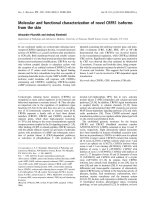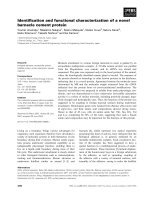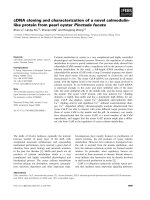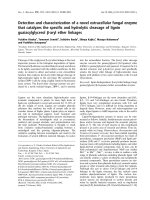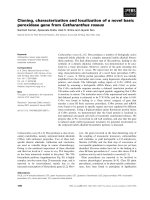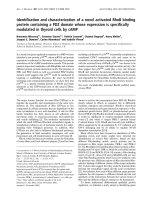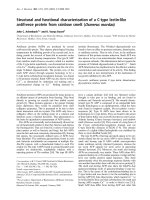Genomic organization and functional characterization of a novel cancer associated gene u0 44
Bạn đang xem bản rút gọn của tài liệu. Xem và tải ngay bản đầy đủ của tài liệu tại đây (5.32 MB, 198 trang )
CAINE LEONG TUCK CHO
Y
NATIONAL UNIVERSITY OF SINGAPORE
2006
GENOMIC ORGANIZATION AND FUNCTIONAL
CHARACTERIZATION OF A NOVEL CANCER
ASSOCIATED GENE – UO-44
GENOMIC ORGANIZATION AND FUNCTIONAL
CHARACTERIZATION OF A NOVEL CANCER
ASSOCIATED GENE – UO-44
CAINE LEONG
TUCK CHOY
BSc
(
Hons
)
A
THESIS SUBMITTED FOR THE DEGREE OF
DOCTOR OF PHILOSOPHY
DEPARTMENT OF PHARMACOLOGY
NATIONAL UNIVERSITY OF SINGAPORE
2006
i
ACKNOWLEDGEMENTS
Memories of happiness, sadness and not to forget frustration throughout these
few years have made this time one of the most enriching and fulfilling days of my
life.
First of all, I would like to thank Professor Philip Keith Moore, the Head of
Department of Pharmacology, for giving me this opportunity to participate in this
post-graduate program. Next, I would also like to thank Professor Hui Kam Man,
the Director of the Division of Cellular and Molecular Research at the National
Cancer Centre of Singapore (NCCS), for giving me a chance to work in NCCS where
all my research was conducted. Most of all, I would love to thank my supervisor
Associate Professor Huynh The Hung, Department of Pharmacology, National
University of Singapore, for his valuable guidance and immense support throughout
this project.
In particular, I would like to extend my greatest gratitude to Choon Kiat, who
has been such an inspiration to me and for being my best buddy in the lab. In addition,
I would also like to express my deepest appreciation to Cedric for guiding me when I
first started this project and for meticulously proofreading this thesis. Most
importantly, I would like to thank to all members of the Molecular Endocrinology
Laboratory at the National Cancer Centre of Singapore, both past and present.
Especially, Chye Sun, Chee Pang, Hung, Esther and Yihui for all their precious
support and encouragement throughout these years. Additionally, I would also like to
thank all the researchers in the Division of Cellular and Molecular Research and
Division of Medical Sciences at the National Cancer Centre of Singapore for always
being so ever ready to offer the use of their equipment and reagents.
ii
Above all, I would like to express my heartfelt gratefulness to my wife
Angeline and my son Rex for being the main driving-force in my life. Additionally, I
would also like to thank my sister, Celian, for always being there for me. Last but not
least, I want to dedicate this thesis to my dad and mum, Tony and Lisa, without
which none of this will be possible.
iii
TABLE OF CONTENTS
ACKNOWLEDGEMENTS
i
TABLE OF CONTENTS
iii
SUMMARY
vi
LIST OF TABLES
viii
LIST OF FIGURES
ix
LIST OF ABBREVIATIONS
xii
AWARDS AND PUBLICATIONS
xv
Chapter 1 LITERATURE REVIEW
1
1.1 Zona Pellucida and CUB Domain Proteins 1
1.1.1 The Zona Pellucida – Conserved Module For Polymerization of
Extracellular Proteins
1
1.1.1.1 Zona Pellucida 1 – 3 2
1.1.1.2
Transforming Growth Factor-β Receptor Type III and
Endoglin
2
1.1.1.3 Deleted in Malignant Brain Tumors 1 (DMBT1) 4
1.1.2 The CUB Domain – In Developmentally Regulated Proteins 5
1.1.2.1 Membrane-Type Serine Protease 1 (MT-SP1) 7
1.1.2.2 CUB Domain Containing Protein 1 (CDCP-1) 8
1.1.2.3 Platelet-Derived Growth Factor D (PDGF-D) 8
1.2 Estrogens 9
1.2.1 Exposure of Estrogen and the Risk of Ovarian Cancer 10
1.2.2 Tamoxifen and Antiestrogens 12
1.2.3 Estrogen Regulated Genes in Ovarian Cancer 13
1.2.3.1 Progesterone Receptor 14
1.2.3.2 Cathepsin D 14
1.2.3.3 C-myc Early Growth Response Gene 15
1.2.3.4 pNR-2/pS2 15
1.2.3.5 Fibulin-1 16
1.2.3.6 HER-2/neu 16
1.2.3.7 Breast and Ovarian Cancer Susceptibility Gene 1 17
1.2.3.8 Kallikreins 18
1.3 Treatment of Ovarian Cancers 18
1.3.1 Surgery and Chemotherapy for Ovarian Cancer 19
1.3.2 Cisplatin Therapy 20
1.3.3 Cisplatin Mode of Action and Molecular Basis of Resistance 21
1.4 RNA interference (RNAi) 25
1.4.1 Discovery and Development of RNAi and siRNAs 25
1.4.2 RNAi Technology in Gynecologic Cancers in-vitro 26
1.4.3 Challenges in siRNA Technology 30
Chapter 2 INTRODUCTION
33
2.1 Isolation of UO-44 (UTCZP) 33
2.2 Estrogen and Tamoxifen Induced UO-44 Expression (ERG-1) 34
2.3 UO-44 Role in Susceptibility in Pancreatitis (ITMAP-1) 34
2.4 Objective of this Study 35
iv
Chapter 3 MATERIALS AND METHODS
36
3.1 Reagents 36
3.2 Cell Lines and Cell Culture 36
3.3 Animals 38
3.4 Probe Labeling 38
3.5 Human Ovarian cDNA Library for Human Ortholog of UO-44 38
3.6 Rapid Amplification of cDNA Ends (RACE) 40
3.7 Cloning of UO-44 cDNAs 41
3.7.1 Cloning of HuUO-44 – A, B, C, D and E transcripts 41
3.7.2 Cloning of RatUO-44 – A, B, C, D and E 42
3.8 Multiple Tissue Expression Array, Multiple Tissue Northern, Cancer
Profiling Array and Cancer Cell Line Profiling Array
43
3.9 Semi-quantitative RT-PCR of Human and Rat UO-44 44
3.10 Quantitative (Real-time) PCR of UO-44 45
3.11 Generation and Transfection HuUO-44-eGFP fusion Constructs 46
3.12 UO-44 Antibodies and Immunohistochemistry 47
3.13 Cisplatin Treatment 49
3.14 Cellular Proliferation Assay 49
3.15 Cytotoxicity Assay 50
3.16 Knockdown of HuUO-44 in NIH-OVCAR3 Through RNA Interference
(RNAi)
50
3.17 Generation of HuUO-44 Stable Transfectants 51
3.18 Flow Cytometry 52
3.19 Computational and Statistical Analysis 53
Chapter 4 RESULTS
55
4.1 Cloning, Sequencing and Characterization of the Human UO-44 55
4.1.1 Screening and Sequencing of HuUO-44 cDNA 55
4.1.2 5’ Rapid Amplification of cDNA Ends (RACE) 57
4.1.3 Cloning of Human UO-44 Variants 59
4.1.4 Genomic Structure of Human UO-44 gene 66
4.1.5 Tissue Distribution Profile of Human UO-44 66
4.2 Establishing a Rat Model for Characterization of UO-44 70
4.2.1 Genomic Structure of Rat UO-44 70
4.2.2 Isolation and Cloning of Rat UO-44 Variants 72
4.2.3 Comparative Genomics of Human, Rat and Mouse UO-44 76
4.2.3 Hormonal Regulation of UO-44 Variants 85
4.2.6 Pregnancy Induced Expression of UO-44 Variants 85
4.3 UO-44 and Cancer 88
4.3.1 Overexpression of Human UO-44 in Ovarian Cancers 88
4.3.2 Expression of Human UO-44 in Ovarian Tissues and Cancer
Cell lines
91
4.3.3 Inhibition of Ovarian Cancer Cell Attachment and Proliferation 97
4.3.4 Cancer Cell Line Profiling Array 97
4.3.5 Involvement of HuUO-44 in Cisplatin Sensitivity 101
4.3.6 Knockdown of HuUO-44 Sensitizes Ovarian Cancer Cells to
Cisplatin
105
4.3.7 Expression of HuUO-44 Conferred Resistance to Cisplatin 114
v
Chapter 5 DISCUSSION
117
5.1 Human UO-44 gene 117
5.1.1 Features in HuUO-44 Gene 117
5.1.2 The Origin of Human HuUO-44 Isoforms 120
5.1.3 UO-44, a Multifunctional Protein 122
5.2 Rat Model for Further Characterization of UO-44 123
5.2.1 UO-44 is Highly Conserved in Human, Mouse and Rat 124
5.2.2 Genomic Organization of Rat UO-44 Gene 127
5.2.3 Rat UO-44 Isoforms 128
5.2.4
Tamoxifen, β-estradiol (E
2
) and Pure Anti-estrogens (ICI
182780) Role in Regulation of Rat UO-44 Isoforms
129
5.2.5 Rat UO-44 a Pregnancy Induced Gene in the Mammary Glands 130
5.3 Human UO-44 and Ovarian Cancers 130
5.3.1 Estrogen-regulated Proteins as Potential New Markers for
Ovarian Cancers
131
5.3.2 HuUO-44 – A Protein Involved in Ovarian Cancer Cell
Adhesion and Cell Motility
132
5.3.3 Involvement of Human UO-44 in Cisplatin Chemoresistance 133
Chapter 6 CONCLUSION AND FUTURE STUDIES
138
REFERENCES
140
APPENDICES
vi
SUMMARY
Ovarian cancer is currently the second leading cause of gynecological
malignancy and cisplatin or cisplatin-based regimens have been the standard of care
for the treatment of advance epithelial ovarian cancers. However, the efficacy of
cisplatin treatment is often limited by the development of drug resistance either
through the inhibition of apoptotic genes or activation of anti-apoptotic genes. This
thesis encompasses the molecular cloning and characterization of a putative
oncogene, UO-44. UO-44 (GenBank accession no. AF022147) is an estrogen
regulated uterine-ovarian specific complementary DNA that was previously isolated
through differential display of a tamoxifen-induced rat uterine cDNA library. The
objective of this study is to further examine the role of this gene in the initiation and
progression of ovarian cancers.
Human UO-44 (HuUO-44) cDNA was obtained through a combination of
screening a human ovarian cDNA library, 5’ RACE and RT-PCR. The gene HuUO-
44 is mapped to chromosome 10q26.13 and contains 9 exons. Putative functional
motifs identified in HuUO-44 are two CUB domains and a zona pellucida domain.
Through reverse-transcription PCR (RT-PCR), four novel spliced variants of HuUO-
44 were isolated; these variants were obtained through a complex series of alternative
splicing events between exons 2 to 6. These HuUO-44 mRNA variant isoforms is
suggested to play a role in regulating gene expression.
Gene expression analysis via the Multiple Tissue Northern blot detected two
HuUO-44 transcripts of approximately 2 and 3 kb in the pancreas. Using the Cancer
Profiling Array, HuUO-44 transcript was found overexpressed in a majority of
ovarian tumors (12 of 14 or 86 %) compared to corresponding normal tissues.
Transfection studies demonstrated the membrane-associated nature of HuUO-44 and
vii
through immunohistochemistry, HuUO-44 was located to the normal ovarian and
ovarian tumor epithelial cells. In ovarian cancer cells (NIH-OVCAR3), HuUO-44 was
detected only at the leading edge of the dividing cells. Importantly, a marked loss in
cell attachment and proliferation was observed in NIH-OVCAR3 cells when cultured
in the presence of a polyclonal HuUO-44 antiserum. These findings suggest the
potential role of HuUO-44 in cell motility, cell-cell interactions and/ or interactions
with the extracellular matrices.
Interestingly, the Cancer Cell Line Profiling Array revealed that the
expression of HuUO-44 was suppressed in the ovarian cancer cell line (SKOV-3)
after treatment with several chemotherapeutic drugs. Similarly, this suppression in
HuUO-44 expression was also correlated to the cisplatin sensitivity in two other
ovarian cancer cell lines NIH-OVCAR3 and OV-90 in a dose dependent manner. To
elucidate the function of HuUO-44 in cisplatin sensitivity in ovarian cancer cell, small
interfering RNAs (siRNAs) were employed to mediate HuUO-44 silencing in ovarian
cancer cell line, NIH-OVCAR3 and SKOV3. HuUO-44 RNA interference (RNAi)
resulted in the inhibition of cell growth and proliferation. Importantly, HuUO-44
RNAi significantly increased sensitivity of NIH-OVCAR3 to cytotoxic stress induced
by cisplatin (P < 0.01). Strikingly, we have also demonstrated that overexpression of
HuUO-44 significantly conferred cisplatin resistance in NIH-OVCAR3 cells (P <
0.05). Taken together, UO-44 is involved in conferring cisplatin resistance; the
described HuUO-44-specific siRNA oligonucleotides that can potently silence HuUO-
44 gene expression may prove to be a valuable pre-treatment target for intra-tumor
therapy of ovarian epithelial cancers.
viii
LIST OF TABLES
No. Title Page
Table 1.1 RNAi agents in drug development. 32
Table 3.1 Sequences of oligonucleotides used for RT-PCR (a), Cloning
(b), Sequencing (c), PCR (d) and 5’ RACE Primer (e).
37
Table 4.1 Summary of the different HuUO-44 spliced variants. 65
Table 4.2 Exon/Intron boundaries of human UO-44. 67
Table 4.3 Exon/Intron boundaries of rat UO-44. 74
Table 4.4 Summary of the different rat UO-44 spliced variants. 78
Table 4.5 Functional modules and their relative functions in the
human, mouse and rat UO-44 promoters.
84
Table 4.6 Sequence and target exons of the HuUO-44 siRNAs U1, U2
and U3*.
106
ix
LIST OF FIGURES
No.
Title Page
Figure 1.1 Schematic representation of the overall architecture of
mouse ZP glycoproteins, ZP1, ZP2 and ZP3.
3
Figure 1.2 Multiple effects of endogenous and synthetic estrogens on
tissues that contribute to estrogen carcinogenesis.
11
Figure 1.3 An overview of pathways involved in mediating cisplatin-
induced cellular effects.
22
Figure 1.4 Factors modulating repair of cisplatin-induced DNA
adducts and regulating replicative bypass.
23
Figure 1.5 Mechanisms involved in inhibiting the apoptotic signal in
cisplatin-resistant tumor cells.
24
Figure 1.6 SiRNA interference mechanism: short hairpin RNAs and
long dsRNAs all are processed by Dicer to form siRNAs.
27
Figure 1.7 Potential applications of RNA interference in cancer
research and therapy
29
Figure 4.1 Library screened HuUO-44 cDNA (GenBank accession
no. AF305835) nucleotide sequence (2126 bp) and
deduced aa sequence (357 aa).
56
Figure 4.2 5’RACE illustration and sizes of the resulting contigs. 58
Figure 4.3 Expression of human UO-44 splice-variants in
normal/tumor ovarian and uterine tissues.
60
Figure 4.4 Illustration of HuUO-44 spliced-variants. 62
Figure 4.5 Full-length human UO-44 (HuUO-44D) nucleotide
sequence (2339 bp) and deduced amino acid sequence
(607 amino acids).
63
Figure 4.6 Graphical representation of human UO-44 genomic
organization in a region within human chromosome 10.
68
x
Figure 4.7 Multiple Tissue Northern (MTN) of HuUO-44. 69
Figure 4.8 Multiple Tissue Expression Array (MTE) of HuUO-44. 71
Figure 4.9 Graphical representation of rat UO-44 genomic
organization in a region within rat chromosome 1.
73
Figure 4.10 Expression of rat UO-44 spliced-variants in the ovary. 75
Figure 4.11 Illustration of rat UO-44 spliced-variants. 77
Figure 4.12 A schematic of UO-44s and other CUB or Zona pellucida
proteins.
79
Figure 4.13 Multiple sequence alignment of rat, mouse and human
UO-44 peptide sequences.
80
Figure 4.14 Comparative genomics analysis of human, mouse and rat
UO-44.
82
Figure 4.15 Common elements framework analysis in the human,
mouse and rat UO-44 promoters.
86
Figure 4.16 Semi-quantitative One-step RT-PCR analysis of UO-44
spliced-variants expression in the uterus of pure anti-
estrogens (ICI 182780), tamoxifen and β-estradiol treated
rats.
87
Figure 4.17 Pregnancy induced expression of UO-44 variants in the
mammary glands.
89
Figure 4.18 Cancer Profiling Array (CPA, normal/ tumor ovary) of
human UO-44.
90
Figure 4.19 Semi-quantitative RT-PCR of HuUO-44 using total RNA
extracted from normal ovarian epithelium, ovarian tumors
and ovarian epithelial cancer cell line (NIH-OVCAR3).
92
xi
Figure 4.20 Transfection study of HuUO-44-eGFP in ovarian cancer
cells (NIH-OVCAR3).
94
Figure 4.21 Immunohistochemical staining of HuUO-44 in an ovarian
cancer cell line NIH-OVCAR3.
95
Figure 4.22 Immunohistochemical staining of HuUO-44 in paraffin-
embedded sections of a representative normal ovarian
epithelial and ovarian epithelial cancer.
96
Figure 4.23 Effects of HuUO-44 antiserum on cell attachment and
proliferation of ovarian cancer cells (NIH-OVCAR3).
98
Figure 4.24 Expression of human UO-44 (HuUO-44) in the ovarian
cancer cell line (SKOV3) treated with 26 individual agents
using the Cancer Cell Line Profiling Array.
100
Figure 4.25 Cytotoxic effect of cisplatin in ovarian cancer cell lines
(NIH-OVCAR3, ES-2, SKOV-3 and OV-90).
102
Figure 4.26 Effect of cisplatin on HuUO-44 expression in ovarian
cancer cell lines (NIH-OVCAR3, ES-2, SKOV-3 and OV-
90).
103
Figure 4.27 Effect of cisplatin on HuUO-44 expression in ovarian
cancer cell lines (NIH-OVCAR3).
104
Figure 4.28 HuUO-44 sequence specific siRNA silencing of HuUO-44
expression in NIH-OVCAR3 ovarian cancer cells.
107
Figure 4.29 Dose dependent silencing of HuUO-44 gene by siRNA in
NIH-OVCAR3 ovarian cancer cells.
110
Figure 4.30 Dose dependent silencing of HuUO-44 by siRNAs in
SKOV-3 ovarian cancer cells.
111
Figure 4.31 HuUO-44 RNAi enhanced chemosensitivity of ovarian
cancer cells, NIH-OVCAR3.
112
Figure 4.32 Overexpression of HuUO-44 conferred cisplatin resistance
in cisplatin-sensitive ovarian cancer cells, NIH-OVCAR3.
115
xii
LIST OF ABBREVIATIONS
α-MEM Alpha Modified Eagle medium
AMD Age-related Muscular Degeneration
BRCA1 Breast and Ovarian Cancer Susceptibility Gene 1
CCP Complement Control Protein
CDCPs CUB Domains-Containing Proteins
CFCS Consensus Furin Cleavage Site
CPA Cancer Profiling Array
CUB Complement Subcomponents – C
1r/C1s, Embryonic Sea
Urchin Protein – U
egf and Bone Morphogenetic Protein 1 –
B
mp1
DMBT1 Deleted in Malignant Brain Tumors 1
dsRNAs Double Stranded RNAs
E
2
Estradiol
ECM Extracellular Matrix
EGF Epidermal Growth Factor
eGFP Enhanced Green Florescence Protein
EMBL European Molecular Biology Laboratory
ER Estrogen Receptor
ERG1 Estrogen Regulated Gene 1
FBS Fetal Bovine Serum
FGF Fibroblast Growth Factor
GAPDH Glyceraldehydes-3-Phosphate Dehydrogenase
GSP Gene Specific Primer
HB-EGF Heparin-Binding EGF-like growth factor
xiii
Hi-Glu-DMEM High glucose Dulbecco’s Modified Eagle Medium
IGF-1 Insulin-like Growth Factor – 1
IP Intraperitoneal
Itmap-1 Integral Membrane Associated Protein – 1
KLKs Kallikreins
LB Luria-Bertani
MTE Multiple Tissue Expression
MTN Multiple Tissue Northern
MT-SP1 Membrane-Type Serine Protease 1
MTT [3-(4,5-dimethylthiazol-2-yl)-2,5-diphenyltetrazolium bromide]
NCBI National Centre for Biotechnology Information
ORF Open Reading Frame
PAN Plasminogen N-terminus
PBS Phosphate Buffer Saline
PCR Polymerase Chain Reaction
PDGF Platelet-Derived Growth Factor
PI Propidium Iodide
PR Progesterone Receptor
PS Penicillin-Streptomycin
RACE Rapid Amplification of cDNA Ends
RGD Arginine-Glycine-Aspartate
RISC RNA-induced silencing complex
RNAi RNA Interference
RT-PCR Reverse Transcription-Polymerase Chain Reaction
SDS-PAGE Sodium Dodecyl Sulphate-Polyacrylamide Gel Electrophoresis
xiv
SIDs SRCR interspersed domains
siRNAs Short Interfering RNAs
SP Signal Peptide
SPDI Secreted Protein Discovery Initiative
SRCR Scavenger Receptor Cysteine Rich
SSC Sodium chloride-Sodium Citrate solution
TBS Tris Buffer Saline
TBST Tris Buffer Saline Tween-20
TF Transcription Factors
TGFR3 Transforming Growth Factor-β Receptor Type III
TM Transmembrane
TMD Transmembrane Domain
UTCZP Uterine Cub Zona pellucida Protein
UTR Untranslated Region
VEGF Vascular Endothelial Growth Factor
ZP Zona Pellucida
xv
LOCAL AND INTERNATIONAL AWARDS
Awarded 1
st
prize for oral presentation at the 5
th
Combined Annual Scientific
Meeting 2004 (“Life Sciences in Singapore.”), National University of Singapore.
Presentation title: Molecular Characterization of a Membrane-Associated Protein
HuUO-44 and its Potential Role in Ovarian Cancer Cell Attachment and
Proliferation.
Awarded 2
nd
prize for oral presentation at the 3
rd
Annual Graduate Student
Society-Faculty of Medicine (GSS-FOM) Meeting 2003, National University
of Singapore. Presentation title: Molecular Cloning and Characterization of a
Putative Oncogene, HuUO-44, in Human Ovarian Carcinogenesis.
Awarded AVON international scholar-in-training award poster presented at
the 94
th
American Association for Cancer Research (AACR), Annual Meeting
2003, Washington D. C., USA. (July 11-14, 2003) Poster title: Molecular
Cloning and Characterization of a Putative Oncogene, HuUO-44, in Human
Ovarian Carcinogenesis.
PUBLICATIONS
Caine Tuck Choy Leong
, Choon Kiat Ong, Sun Kuie Tay and Hung Huynh.
Silencing expression of UO-44 (CUZD1) using small interfering RNA
sensitize human ovarian cancer cells cisplatin in-vitro. Oncogene 2007 Feb 8;
26(6):870-80. (Appendix 2)
Caine Tuck Choy Leong
, Cedric Chuan Young Ng, Choon Kiat Ong, Chee
Pang Ng and Hung Huynh. Molecular Cloning and Characterization of a
Putative Transmembrane Protein, HuUO44, Overexpressed in Human Ovarian
Tumors. Oncogene 2004 Jul 22; 23(33):5707-18. (Appendix 1)
GRANT
This project was awarded a National Medical Research Council of Singapore
grant (NMRC/0887/2004) of $199,382.50 for the period from 1
st
Jan 2005 to
31
th
Dec 2008 to Huynh Hung. (Grant Titled: Functional Characterization of
HuUO-44 an estrogen regulated membrane-associated protein, as a Biomarker
for Ovarian Cancer Prognosis Diagnosis and Treatment.)
INVITED TALK/ PRESENTATION
Invited Speaker, Bio-Rad Laboratories (Real-time PCR – Strategies and
Applications), National University of Singapore (19
th
May 2006).
Poster presentation, Combined Scientific Meeting 2005, Singapore. Poster
title: Tamoxifen, Estrogens and Anti-estrogens Regulation of a Uterine and
Ovarian Specific Protein, UO-44, that is Overexpressed in Ovarian Tumours.
LITERATURE REVIEW
1
Chapter 1 LITERATURE REVIEW
1.1 Zona Pellucida and CUB Domain Proteins
1.1.1 The Zona Pellucida – Conserved Module For Polymerization of
Extracellular Proteins
Zona pellucida (ZP) domains are found in many eukaryotic extracellular
proteins of diverse molecular architecture and biological functions (Bork and Sander,
1992; Wassarman et al., 2001). These include egg coat proteins, inner ear proteins,
urinary proteins, pancreatic proteins, transforming growth factor-β receptors, immune
defense proteins, nematode cuticle components, and fly proteins (Bork and Sander,
1992; Litscher et al., 1999; Wassarman et al., 2001).
ZP domains proteins often contain other types of domains, such as proline-rich
(P) or trefoil (Bork and Sander, 1992; Carr, 1992), epidermal growth factor (Appella
et al., 1988), CUB or BMP (Bork and Beckmann, 1993; Fukagawa et al., 1994), PAN
(plasminogen N terminus) (Tordai et al., 1999), SRCR (scavenger receptor cysteine
rich) (Resnick et al., 1994), von Willebrand factor (Ruggeri, 2003), or other domains
(Bork et al., 1996; Letunic et al., 2004). Most ZP domain proteins are glycosylated
and possess an amino-terminal (N-terminal) signal peptide and either a carboxyl
terminal (C-terminal) putative transmembrane domain (TMD) or glycosyl
phosphatidylinositol- (GPI-) anchor (Jovine et al., 2004). ZP proteins have been
characterized from a wide variety of mammalian eggs, including rodents,
domesticated animals, marsupials, and primates (Breed et al., 2002; Spargo and Hope,
2003). In general, ZP proteins are found in filaments and/ or matrices, which is
consistent with the function of this domain in protein polymerization (Jovine et al.,
LITERATURE REVIEW
2
2002). Although ZP proteins are found in proteins of diverse functions, this domain is
likely to play a common role.
1.1.1.1 Zona Pellucida 1 – 3
ZP is a thick extracellular coat that surrounds all mammalian eggs and plays a
vital role in oogenesis, fertilization and preimplantation development (Wassarman,
1988; Wassarman et al., 2001). There are three glycosylated isoforms of ZP in the
mouse, named ZP1 – 3, these three isoforms has a ZP domain near to the C-terminus,
a signal peptide at the N-terminus, a consensus furin cleavage site (CFCS), a C-
terminal putative TMD, and a short cytoplasmic tail (Figure 1.1). These proteins are
concurrently synthesized, secreted, and assembled into ZP as mouse oocytes grow.
The secreted from of ZP1 – 3 lack signal peptides and is cleaved at the CFCS. It is
apparent that ZP1 – 3 have regions of similarity, suggesting that these regions may be
derived from a common ancestral gene.
1.1.1.2 Transforming Growth Factor-
β
Receptor Type III and Endoglin
Transforming growth factor-β receptor type III (TGFR3), or betaglycan, is the
most abundant TGF-β binding protein at the cell surface. Among its essential
functions, TGFR3 plays an important role in the restructuring of blood vessels during
angiogenesis in mammals (Bandyopadhyay et al., 1999; Bandyopadhyay et al., 2002).
It contains a signal peptide at the N-terminus, a ZP domain, a C-terminal putative
TMD, and a cytoplasmic tail (Lopez-Casillas et al., 1991; Wang et al., 1991; Moren
et al., 1992; Lin et al., 1992). TGFR3 binds all 3 TGF-β isoforms with high affinity
and has been suggested to facilitate binding of TGF-β to TGF-β type II receptor
(Lopez-Casillas et al., 1991; Wang et al., 1991; Lopez-Casillas et al., 1993).
LITERATURE REVIEW
3
Figure 1.1 Schematic representation of the overall architecture of mouse ZP
glycoproteins, ZP1, ZP2 and ZP3. The polypeptide of each ZP glycoprotein is
drawn to scale, with the N and C termini indicated. Key features of the polypeptide,
including the N-terminal signal peptide (green), P or trefoil domain (yellow), ZP
domain (red), CFCS (X), TMD (black), and C-terminal propeptide region (blue bar)
are depicted. Only putative N-linked glycosylation sites, conforming to the strict
pattern Asn-X-Ser/Thr-X, where X can be any amino acid other than Pro, as shown
(adapted from Jovine et al., 2005).
LITERATURE REVIEW
4
Endoglin (~180 kDa M
r
; disulfide-linked homodimer) is a membrane
glycoprotein, which is structurally related to TGFR3. This protein binds TGF-β
isoforms 1 and 3 with high affinity through the association with the type II receptor
(Fonsatti et al., 2001; Sorensen et al., 2003) and is crucial for the cardiovascular
development and vascular remodeling (Fonsatti et al., 2003). In addition, mice
deficient in endoglin showed signs of defective angiogenesis. The interaction between
endoglin and TGFR3 may therefore function to regulate the TGF-β signaling
pathways in cancer (Li et al., 1999; Wong et al., 2000; Parker et al., 2003; Copland et
al., 2003).
1.1.1.3 Deleted in Malignant Brain Tumors 1 (DMBT1)
DMBT1 (deleted in malignant brain tumors 1) is a scavenger receptor
cysteine-rich (SRCR) gene at chromosome 10q25.3-26.1 and has been initially cloned
by virtue of its frequent homozygous deletion and lack of expression (Mollenhauer et
al., 1997; Somerville et al., 1998; Mori et al., 1999; Wu et al., 1999). Though
DMBT1 has been regarded as a candidate tumor suppressor gene for the human brain,
lung and digestive tract cancers; it differs substantially from conventional tumor
suppressors and is in fact potentially multifunctional (Mollenhauer et al., 2000;
Mollenhauer et al., 2001; Mollenhauer et al., 2002b; Mollenhauer et al., 2002c;
Mollenhauer et al., 2004). DMBT1 is a relatively large secreted glycoprotein with up
to 13 N-terminal SRCR domains separated by short serine-theonine-rich amino acid
motifs known as SRCR interspersed domains (SIDs) (Mollenhauer et al., 2002a),
which are potential sites for extensive O-glycosylation. The three major functional
domains found within DMBT1 are SRCR, 2 CUB and ZP, these are commonly
LITERATURE REVIEW
5
known to mediate protein-protein interactions (Wassarman, 1988; Bork and Sander,
1992; Bork and Beckmann, 1993;J ovine et al., 2005).
Takito et. al reported a mouse ortholog of DMBT1, Hensin, which is
expressed in virtually all epithelia and brain (Takito et al., 1999). This protein
contains 8 SRCR, 2 CUB and a ZP domain, in the presence of gelactin-3 it assembles
into dimers and tetramers to form long fibres in the ECM (Hikita et al., 1999; Hikita
et al., 2000). Similar to DMBT1, this alternatively spliced form is deleted in a large
number of epithelia tumors and is suggested to be involved in apical secretion and
endocytosis (Hikita et al., 1999; Al Awqati et al., 1999).
In recent years, ZP domain has been identified in various proteins of diverse
functions and it is a module that is frequently found in extracellular proteins that
polymerize into higher-order structures, such as filaments and matrices. ZP proteins
are often glycosylated and have mucin-like properties. These proteins are often found
to contain other functional modules (eg. CUB, EGF, and PAN domains) and perform
functions distinct from the structural role played by the ZP domain. Owing to its
transmembrane nature, ZP proteins may also serve as receptors or
mechanotransducers. Its is clear that ZP proteins is a large and important family of
proteins that will continue to grow in size and its association with the onset of
diseases will be of great interest to researchers in the many years to come.
1.1.2 The CUB Domain – In Developmentally Regulated Proteins
Communications between cells during the process of development requires a
network of distinct interactions. Programming of these interactions in nature is most
likely created by combining structurally and functionally independent domains
(modules), which are often the only linkage between otherwise distinct proteins
LITERATURE REVIEW
6
(Doolittle and Bork, 1993). The extracellular CUB domain is an example of such a
module that is found in functionally diverse, mostly developmentally regulated
proteins. It was first identified in the complement subcomponents C1s and C1r
(C1s/C1r), which are proteins found in the circulating blood (Leytus et al., 1986; Tosi
et al., 1987). This domain was named after the first three identified proteins of this
family, the Complement subcomponents – C
1r/C1s, the embryonic sea urchin protein
– U
egf and the bone morphogenetic protein 1 – Bmp1 (Bork, 1991).
Though this domain is found in functionally diverse proteins, the majority of
the CUB domains-containing proteins (CDCPs) are developmentally regulated and
have a vital function in embryonic development (Bork and Beckmann, 1993). These
proteins include growth factors, proteases, activators of the complement system, and
proteins involved in cell adhesion or interaction with the extracellular matrix
components (Stohr et al., 2002). Almost all CUB domains contain four conserved
cysteines, which probably form two disulfide bridges (C1 – C2, C3 – C4). The
structure of the CUB domain is very similar to that of immunoglobulins and play a
crucial role in cell adhesion (Duke-Cohan et al., 1998).
Amongst the first CDCPs identified was the complement subcomponents C1s
and C1r. Both proteins contain two CUB domains, an epidermal growth factor (EGF)-
like domain, two complement control protein (CCP) domains and a trypsin family
serine protease domains, which play a part in the mammalian complement system
(Tosi et al., 1989a; Tosi et al., 1989b). These two CDCPs also aid in protease
activation of trypsinogen and cleavage of collagen and fibronectin (Bork and
Beckmann, 1993). Another CDCP, the vertebrate bone morphogenetic protein 1
(BMP-1) is a glycosylated metalloproteinase that induces cartilage and bone
formation through the synthesis of a normal extracellular matrix. The CUB domains
LITERATURE REVIEW
7
found in BMP-1 has been shown to play a role in the secretion and stability of the
protein (Garrigue-Antar et al., 2002).
Embryonic development and cancer can be viewed as flip sides of the same
coin. During embryogenesis, signal transduction pathways result in basic cell
behaviors such as programmed cell death, proliferation, migration and differentiation.
During oncogenesis, these same signal transduction cascades are misinterpreted,
pathologically reactivated or ignored, resulting in aberrant cellular behaviors.
Analogous to this assumption, several CDCPs listed below have been shown to play a
role in carcinogenesis.
1.1.2.1 Membrane-Type Serine Protease 1 (MT-SP1)
Both the human and mouse matriptase/MT-SP1, a matrix-degrading
transmembrane serine proteinase, contains an arginine-glycine-aspartate (RGD)
integrin-binding motif in the first CUB domain (Netzel-Arnett et al., 2003). It has also
been reported that the removal of the cytoplasmic and transmembrane regions in MT-
SP1 causes the protein to remain membrane bound on the surface of COS cells
(Tsuzuki et al., 2005). This suggests the involvement of the CUB motif in integrin-
mediated cell surface binding by regulating cell-cell and/ or cell-substratum
adhesions. Interestingly, MT-SP1 is
highly expressed in prostate, breast, and
colorectal cancers in
vitro and in vivo (Oberst et al., 2001), and Takeuchi et al. have
demonstrated that inhibition of this enzyme suppresses
both primary tumor growth
and metastasis in a rat model of prostate
cancer (Takeuchi et al., 1999). Many of these
membrane anchored serine proteases have restricted tissue distribution in normal
cells, but the expressions of these proteins are often misregulated during
LITERATURE REVIEW
8
tumorigenesis. Targeting these membrane anchor serine proteases, thus reveal new
approaches for treatment of cancers and other diseases.
1.1.2.2 CUB Domain Containing Protein 1 (CDCP-1)
The CUB domain containing protein-1 (CDCP-1) is a transmembrane
molecule that is expressed in metastatic colon, lung and breast cancers (Scherl-
Mostageer et al., 2001; Buhring et al., 2004). More recently, strong expression
CDCP1 protein expression was found on the surface of highly metastatic hepatic cell
line M
+
Hep3 (Hooper et al., 2003). In their report, normal colon tissues expression of
CDCP1 was restricted to cell surface of the epithelial cells, while cancerous colon
tissues expressed high levels of CDCP1 in the mucus of malignant glands (Hooper et
al., 2003). Taken together, these findings suggest that the upregulation of CDCP1
functions to modulate the cell substrate adhesion or interaction with the extracellular
matrices.
1.1.2.3 Platelet-Derived Growth Factor D (PDGF-D)
The platelet-derived growth factor (PDGF) protein family is a strong
stimulator of cell proliferation, chemotaxis and transformation. It has been known to
play a key role in cell-cell communication for normal development and also during
pathogenesis (Rosenkranz and Kazlauskas, 1999; Yu et al., 2003). The PDGF
isoforms exert their biological functions through the activation of two structurally
related cell surface receptor tyrosine kinases (α-PDGFR and β-PDGFR) (Deuel,
1987; Rosenkranz and Kazlauskas, 1999). The recently discovered PDGF C and D
isoforms have a unique two-domain structure with an amino-terminal CUB domain
and a carboxyl-terminal PDGF/ vascular endothelial growth domain. Ustach et al.


